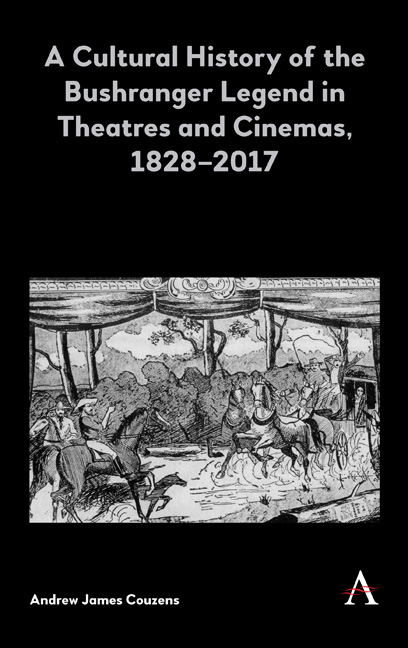Book contents
- Frontmatter
- Contents
- List of Figures
- Acknowledgements
- Introduction: Defining the Bushranger Legend
- Part 1 Establishing the Legend
- 1 The First Bushranger Melodramas
- 2 Alfred Dampier and the Nationalist Melodrama
- 3 Wild West Shows and Wild Australia
- 4 Hippodramas and Edward Irham Cole
- Part 2 Developing the Legend
- Part 3 Fragmenting the Legend
- Conclusion
- Bibliography
- Index
4 - Hippodramas and Edward Irham Cole
from Part 1 - Establishing the Legend
Published online by Cambridge University Press: 14 February 2019
- Frontmatter
- Contents
- List of Figures
- Acknowledgements
- Introduction: Defining the Bushranger Legend
- Part 1 Establishing the Legend
- 1 The First Bushranger Melodramas
- 2 Alfred Dampier and the Nationalist Melodrama
- 3 Wild West Shows and Wild Australia
- 4 Hippodramas and Edward Irham Cole
- Part 2 Developing the Legend
- Part 3 Fragmenting the Legend
- Conclusion
- Bibliography
- Index
Summary
Though Australian Wild West shows made significant contributions to establishing popular attitudes to the bush and connecting these to national self- image their evocation of the bushranger legend was rarely explicit. Their celebration of the bush had implications for representations of bushrangers, but it was left to a similar form of live entertainment, the hippodrama, to turn bushranging into a local, popular spectacle. Australian hippodramas represent a conflation of European conventions, collaboration with American Wild West showmen and a nativist populism that emerged in the bushranger melodramas produced by Edward Irham Cole's Bohemian Dramatic Company in their hippodrome. Cole's company established the bushranger legend as a workingclass, populist one, leaving behind some of the consensus seeking that defined Alfred Dampier's efforts. I interrogate the materials relating to showman Edward Irham Cole in the Bohemian Cole collection held at the Mitchell Library in Sydney. The photographs and ephemera in this collection unveil both the iconography used when depicting bushrangers and the spaces in which these shows took place, demonstrating how bushrangers were visually associated with an Australian bush identity for domestic audiences.
Hippodrama became prominent in London and Paris in the early eighteenth century, and a basic knowledge of their history is essential to understanding Cole's hippodrome shows in Australia, especially with regards to the theatrical spaces. Arthur Saxon defines hippodrama as ‘a play in which trained horses are considered as actors, with business, often leading actions, of their own to perform’. However, Saxon broadens his working definition to include ‘any play in which horsemanship was prominently displayed’; these were grand spectacles, including military displays, historical reenactments and exotic fantasies.
Hippodramas were usually performed in venues combining characteristics of traditional theatre spaces and circus tents. Charles Hughes, a defector from famed London circus proprietor Astley's, built the first such structure in 1782, incorporating both a ring and a stage into the performance space to combine elements of circus novelties with those of narrative theatre. Astley's emulated this structure and began to incorporate pantomimes and ballets to accompany its circus acts. The synthesis of circus and theatre became popular enough to encourage many of the legitimate theatres – those with stages large and sturdy enough to support it at least – to introduce equestrian performances at their own venues, even incorporating these spectacles into melodramas.
- Type
- Chapter
- Information
- Publisher: Anthem PressPrint publication year: 2019



